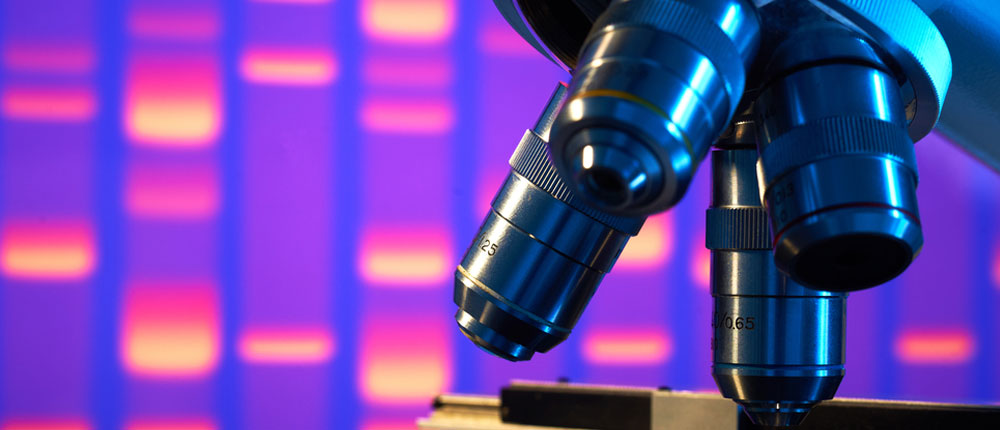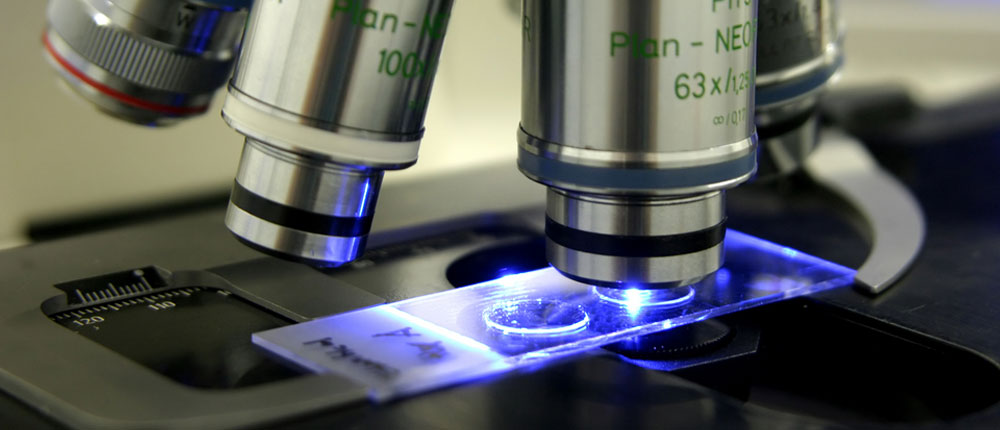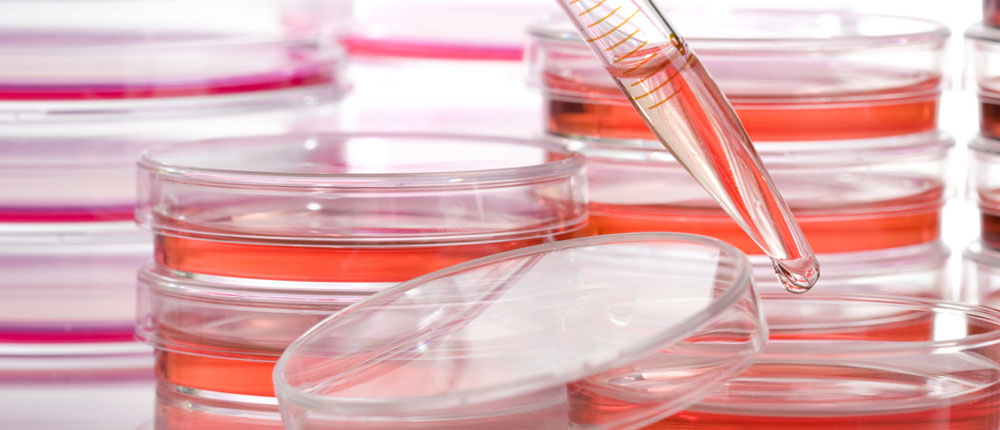Stem cells – a gift of nature. Every time cells within our body age or die, they have to be replaced. Hematopoietic cells e.g. have a very short lifetime and are renewed on a daily basis. Acute situations such as accidents involving injuries of tissues (e.g. cuts, punctures) on the other hand call for immediate and fast tissue renewal.
For all these cases, nature has implemented a repair instrument: the stem cells. There are several sources of stem cells within our body that differ in accessibility and yield.
Stem cells are accompanying us at all times – as embryonic stem cells during the earliest developmental stages to adult stem cells in the mature organism. They are the reason for our bodies own regenerative potential. Responsible for this are two unique properties of stem cells:
- Stem cells are largely unspecialized precursor cells that are capable to develop into various cell types and tissues. This process can be triggered by stimuli from the environment and is called differentiation.
- In contrast to specialized/differentiated cells, stem cells can divide almost indefinitely. Therefore, they can build new stem cells whenever needed.
The stem cell variety
Stem cells are classified according to their origin and differentiation potential. Totipotent (lat. totus = whole) stem cells possess the full differentiation capacity. Starting with them, a whole mature organism can be formed. Pluripotent (lat. plus = many) stem cells have a similar capacity, however, they cannot give rise to a complete organism. Multipotent (lat. multus = numerous) stem cells are more specialized, they can only differentiate into cells of a distinct line. Mesenchymal stem cells (MSCs) e.g. are multipotent. They are precursors of bone, cartilage, muscle, liver or fat cells.
Embryonic stem cells
The whole human organism originates from one (totipotent) fertilized egg cell (zygote). The embryonal daughter stem cells can produce more than 200 different cell types, however, since they cannot intrinsically give rise to a new organism, they are called pluripotent. These embryonic stem cells are harvested from the blastocyst 5-7 days after fertilization.
Due to their extraordinary differentiation potential, human embryonal stem cells are of great interest for basic research as well as medical science. On the same time, their use raises mayor ethical concerns since a blastocyst –an early stage of the embryo – has to be destroyed to isolate these cells. Furthermore, embryonal stem cells harbor the risk to form aggressive teratoma (tumors) when transplanted. Therefore, their use for standard therapies is not acceptable from our perspective.
Induced pluripotent stem cells
Induced pluripotent stem cells (iPSCs) can be artificially generated in the lab by reprogramming tissue specific cells (e.g. skin). They exhibit similar features compared to embryonal stem cells, and hence offer a great opportunity for medical applications. In contrast to their natural occurring counterpart, there are no ethical concerns associated with their use. On the downside, iPSCs are also prone to malignant degeneration. This increased risk of cancer formation in patients renders iPSCs only limited suitable for therapies.
Adult stem cells
Stem cells also exists in the mature organism in multiple tissues. They reside in the bone marrow, brain, liver, adipose tissue, skin and blood vessels. Adult stem cells are responsible for the regeneration of the surrounding tissues. They have a reduced potential to differentiate when compared to embryonal stem cells and are therefore called multipotent. On the other hand, there is no cancer risk associated with their use in new therapies. Therefore, they are of great value for medicine and are being utilized for the treatment of a multitude of conditions and disease.
Mesenchymal stem cells such as ASCs (adipose-derived stem cells) are precursors of the supportive and connective tissue. ASCs have a high capacity to proliferate and posess anti-inflammatory properties. Additionally, ASCs can differentiate in a variety of cell types, including muscle, cartilage, bone and liver cells, to replace damaged tissues. Therefore, they are perfectly suited for therapeutic applications in degenerative disease such as arthrosis, liver disease (acute liver failure, cirrhosis) or autoimmune disease such as multiple sclerosis, lupus or diabetes type I.
Mesenchymal stem cells can be isolated from almost all tissues, including bone marrow, cartilage, fat, muscle and liver tissue, blood and amniotic liquid. Still, MSCs are mostly isolated from bone marrow despite the relative complex extraction procedure (bone marrow punctation performed under anesthesia) and the fact that the number of obtained cells is comparably small.
Adipose tissue - a natural resource of mesenchymal stem cells
The extraction of mesenchymal stem cells from adipose tissue (ASCs) is comparatively gentle and simple:
- Adipose tissue is easily accessible and can be harvested via liposuction (minimal invasive), eliminating the risk of anesthesia. This procedure is even feasible for slender patients since only small volumes (milliliter) of adipose tissue are needed for the stem cell extraction.
- Adipose tissue provides a potent reservoir of therapeutically effective mesenchymal stem cells. It contains about 500 – 1000 times more mesenchymal stem cells than bone marrow, and is available in large quantities.
- The amount of ASCs remains relative constant throughout lifetime, whereas the bone marrow stem cell content decreases drastically with age.
The clinical application of adipose-derived stem cells is still in a very early stage. However, three important properties of ASCs have been demonstrated in scientific publications rendering them an ideal target for new therapies:
- Anti-inflammatory effects: The inflammatory response is a natural defense mechanism of the body towards external stress. In many cases, a part of the affected tissue is necrotized and rejected. Progressive inflammation, however, can destroy entire tissues and even induce organ failure. Therefore, it is critical to recognize and control inflammation early on. The conventional treatment relies on anti-inflammatory drugs. New therapeutic approaches based on stem cells could potentially eliminate the need for medication: ASCs are recruited to the site of inflammation within the body upon administration and secrete anti-inflammatory cytokines, thus, locally managing inflammatory processes (e.g. in osteoarthritic joints or during wound healing).
- Regeneration (cell renewal): The body’s own potential to self-regeneration of damaged tissues is limited. Though, the ability of adipose-derived stem to replace damaged tissue and organs has been demonstrated in studies worldwide. How do ASCs accomplish this task? They integrate into the impaired tissue and differentiate into the required cell type (muscle, cartilage, bone, nerve or fat cells).
- Homing: ASCs innately migrate to sites of inflammation within the patient, as shown in recent scientific publications. Consequently, this allows the systemic administration (non-invasive infusion) of the stem cells in many disease.






